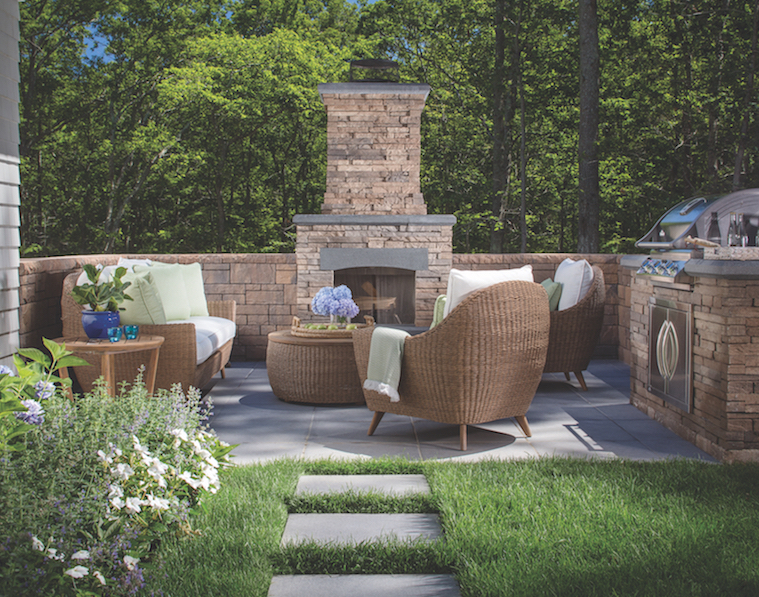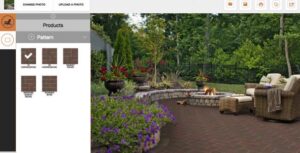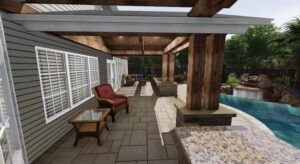Technology in Hardscape Design: Novelty or Necessity?

By Joe Raboine
Even for the savviest homeowners, hardscaping can sometimes be a tough sell. After all, a large project can require wholly reimagining a beloved outdoor space. Who knows how a well-cultivated backyard might look after a fire pit is placed in the middle of it? Does that driveway paver truly match the house color? Will a state-of-the-art outdoor kitchen flow seamlessly as an extension of the home?
 These can be tough questions to answer – no matter how many hand sketches or renderings an owner sees. That’s where design software, 3D renderings and even virtual reality (VR) come in. Design software has quickly become a game-changing tool for contractors, salespeople and homeowners. Tools such as 3D renderings give clients real-world perspectives that put hardscaping in context, providing them with an eye-opening preview of how new features will appear on their own properties.
These can be tough questions to answer – no matter how many hand sketches or renderings an owner sees. That’s where design software, 3D renderings and even virtual reality (VR) come in. Design software has quickly become a game-changing tool for contractors, salespeople and homeowners. Tools such as 3D renderings give clients real-world perspectives that put hardscaping in context, providing them with an eye-opening preview of how new features will appear on their own properties.
So, is technology in hardscaping a novelty or necessity? Renderings, videos and VR minimize the issues that might arise if homeowners can’t quite visualize a project in their outdoor space. That said, VR provides an additional aspect as homeowners are immersed in their new backyard, making for a powerful emotional connection – a major driver for adoption of the technology. While VR isn’t perfect yet in hardscape design, it’s a powerful tool that is here to stay.
The visual and immersive aspects of VR help homeowners come to decisions more quickly, as they are able visualize their new outdoor living space in real time. Contractors can show a homeowner their space through the VR goggles, make a few quick revisions to the plan, and move forward with the project – saving them valuable hours by eliminating the need to update renderings, hold revision meetings, and meet with customers for additional presentation appointments.
According to Zach Hinkle, owner of Hinkle Hardscapes, VR is a useful tool that helps his team close deals as much as a week sooner than when using 2D designs or 3D renderings alone.
VR and 3D renderings offer several perks and benefits for contactors and homeowners alike. For contactors, design software implementation:
- Eliminates questions upfront, making projects run more smoothly from start to finish. This leads to pleased customers and, in turn, referrals and more repeat business.
- Reduces the amount of time spent on renderings, which increases the amount of time available for contactors to spend on selling and managing projects.
- Leads to increased ROI as the number of site visits to close projects decreases.
- Helps streamline the process of selling and installing hardscapes.
- The ability to give customers a better visualization of the overall project and walk them through two to three viewpoints of the design. This give contractors the opportunity to answer any questions that arise.

VR can add meaningful benefits to any kind of hardscaping project, but there are a few that work particularly well for the medium – even outpacing 3D renderings. Spaces that incorporate quite a few vertical elements, for example, can be especially difficult to envision with new features. VR is an easy solution. Domineering new additions, such as outdoor kitchens or fire features, can be much easier to picture using VR. There’s also the broader issue of matching and flow – i.e., the question of how colors will look together, how different features will interact with each other and how movement between spaces will be restricted or enabled. Again, VR becomes an attractive option when considering the full picture of a home.
Jarett Crump, landscape designer with MW Lawn & Landscape Inc., noted that he has been able to utilize VR to visually communicate with both his clients and his crews throughout the design process and during construction. For Crump, VR has been incredibly valuable for not only selling projects but also for keeping production moving forward.
But, how can contactors phase out 2D designs and sketches and implement VR and design software into their everyday business? With so many projects vying for time, contactors have to decide whether or not the benefits outweigh the effort to learn and implement technology into their day-to-day practice.
“I believe that using VR along with 3D renderings for our hardscape projects has helped us to differentiate ourselves as a cutting-edge company that utilizes the latest technology in the green industry,” said Crump. “As we continue using VR in addition to design software, we are able to show both clients and crews what the end product will look like. In turn, our profits, as well as referral and repeat business, will continue to increase.”
If a contractor is already using software to create renderings, then the level of expertise needed to make the transition to VR is minimal. There’s even a few software packages on the market now that allow contactors who are designing their own renderings to choose VR as an option. However, it can be daunting to learn the software itself for contractors who are not already creating their own renderings.
Crump’s words of advice for contactors who are not yet using technology? “Give it a shot, it’s a great tool to use for both sales and production. It will help your crews better understand what you have sold to the client and what the client’s expectations are.”
There are still plenty of new spaces to explore in the world of design technology. The idea has been around for decades, and even though it’s finally reaching a critical mass, there’s still a long way to go toward making it the industry standard. The possibilities are exciting for design technology overall, with VR on the forefront of the industry and expanding into multiple facets of the business. In the meantime, this is the time to invest in the technology for hardscaping and, potentially, a myriad of other renovation needs.
Joe Raboine, residential business manager at Belgard, believes that helping homeowners better visualize a planned design is the key to growing business for hardscape designers and installers, as well as the industry as a whole. Working with Belgard Authorized Contractors, Raboine leads the Belgard Design Studio team. A former contractor, he is an expert designing custom 3D renderings for outdoor spaces and thought leader in hardscape design and technology.
Since 1995, Belgard’s locally made and nationally backed products have transformed thousands of residential and commercial properties in North America. For more information, visit www.Belgard.com or visit www.belgard.com/professional-resources to learn about Belgard’s products and partner programs.



